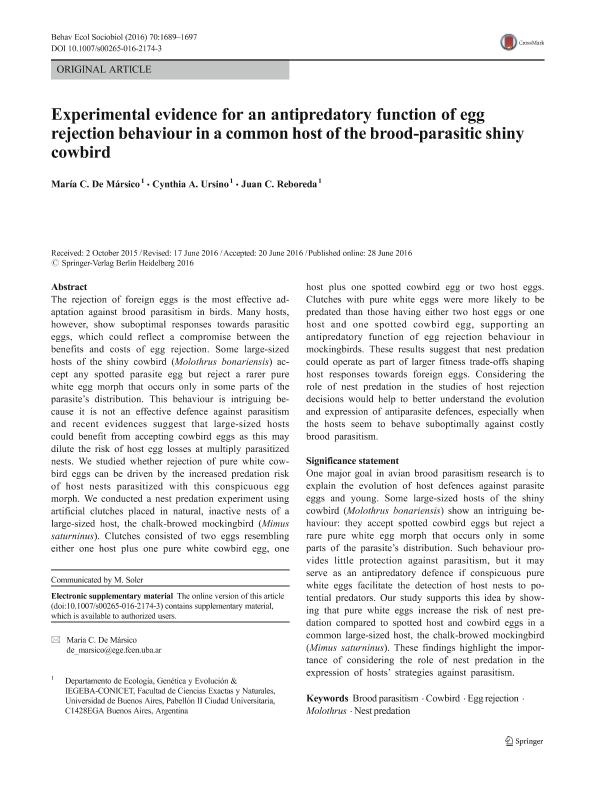Mostrar el registro sencillo del ítem
dc.contributor.author
de Marsico, Maria Cecilia

dc.contributor.author
Ursino, Cynthia Alejandra

dc.contributor.author
Reboreda, Juan Carlos

dc.date.available
2018-10-01T19:56:30Z
dc.date.issued
2016-10
dc.identifier.citation
de Marsico, Maria Cecilia; Ursino, Cynthia Alejandra; Reboreda, Juan Carlos; Experimental evidence for an antipredatory function of egg rejection behaviour in a common host of the brood-parasitic shiny cowbird; Springer; Behavioral Ecology And Sociobiology; 70; 10; 10-2016; 1689-1697
dc.identifier.issn
0340-5443
dc.identifier.uri
http://hdl.handle.net/11336/61443
dc.description.abstract
Abstract: The rejection of foreign eggs is the most effective adaptation against brood parasitism in birds. Many hosts, however, show suboptimal responses towards parasitic eggs, which could reflect a compromise between the benefits and costs of egg rejection. Some large-sized hosts of the shiny cowbird (Molothrus bonariensis) accept any spotted parasite egg but reject a rarer pure white egg morph that occurs only in some parts of the parasite’s distribution. This behaviour is intriguing because it is not an effective defence against parasitism and recent evidences suggest that large-sized hosts could benefit from accepting cowbird eggs as this may dilute the risk of host egg losses at multiply parasitized nests. We studied whether rejection of pure white cowbird eggs can be driven by the increased predation risk of host nests parasitized with this conspicuous egg morph. We conducted a nest predation experiment using artificial clutches placed in natural, inactive nests of a large-sized host, the chalk-browed mockingbird (Mimus saturninus). Clutches consisted of two eggs resembling either one host plus one pure white cowbird egg, one host plus one spotted cowbird egg or two host eggs. Clutches with pure white eggs were more likely to be predated than those having either two host eggs or one host and one spotted cowbird egg, supporting an antipredatory function of egg rejection behaviour in mockingbirds. These results suggest that nest predation could operate as part of larger fitness trade-offs shaping host responses towards foreign eggs. Considering the role of nest predation in the studies of host rejection decisions would help to better understand the evolution and expression of antiparasite defences, especially when the hosts seem to behave suboptimally against costly brood parasitism. Significance statement: One major goal in avian brood parasitism research is to explain the evolution of host defences against parasite eggs and young. Some large-sized hosts of the shiny cowbird (Molothrus bonariensis) show an intriguing behaviour: they accept spotted cowbird eggs but reject a rare pure white egg morph that occurs only in some parts of the parasite’s distribution. Such behaviour provides little protection against parasitism, but it may serve as an antipredatory defence if conspicuous pure white eggs facilitate the detection of host nests to potential predators. Our study supports this idea by showing that pure white eggs increase the risk of nest predation compared to spotted host and cowbird eggs in a common large-sized host, the chalk-browed mockingbird (Mimus saturninus). These findings highlight the importance of considering the role of nest predation in the expression of hosts’ strategies against parasitism.
dc.format
application/pdf
dc.language.iso
eng
dc.publisher
Springer

dc.rights
info:eu-repo/semantics/openAccess
dc.rights.uri
https://creativecommons.org/licenses/by-nc-sa/2.5/ar/
dc.subject
Brood Parasitism
dc.subject
Cowbird
dc.subject
Egg Rejection
dc.subject
Molothrus
dc.subject
Nest Predation
dc.subject.classification
Otras Ciencias Biológicas

dc.subject.classification
Ciencias Biológicas

dc.subject.classification
CIENCIAS NATURALES Y EXACTAS

dc.title
Experimental evidence for an antipredatory function of egg rejection behaviour in a common host of the brood-parasitic shiny cowbird
dc.type
info:eu-repo/semantics/article
dc.type
info:ar-repo/semantics/artículo
dc.type
info:eu-repo/semantics/publishedVersion
dc.date.updated
2018-10-01T16:12:29Z
dc.identifier.eissn
1432-0762
dc.journal.volume
70
dc.journal.number
10
dc.journal.pagination
1689-1697
dc.journal.pais
Alemania

dc.journal.ciudad
Berlin
dc.description.fil
Fil: de Marsico, Maria Cecilia. Consejo Nacional de Investigaciones Científicas y Técnicas. Oficina de Coordinación Administrativa Ciudad Universitaria. Instituto de Ecología, Genética y Evolución de Buenos Aires. Universidad de Buenos Aires. Facultad de Ciencias Exactas y Naturales. Instituto de Ecología, Genética y Evolución de Buenos Aires; Argentina
dc.description.fil
Fil: Ursino, Cynthia Alejandra. Consejo Nacional de Investigaciones Científicas y Técnicas. Oficina de Coordinación Administrativa Ciudad Universitaria. Instituto de Ecología, Genética y Evolución de Buenos Aires. Universidad de Buenos Aires. Facultad de Ciencias Exactas y Naturales. Instituto de Ecología, Genética y Evolución de Buenos Aires; Argentina
dc.description.fil
Fil: Reboreda, Juan Carlos. Consejo Nacional de Investigaciones Científicas y Técnicas. Oficina de Coordinación Administrativa Ciudad Universitaria. Instituto de Ecología, Genética y Evolución de Buenos Aires. Universidad de Buenos Aires. Facultad de Ciencias Exactas y Naturales. Instituto de Ecología, Genética y Evolución de Buenos Aires; Argentina
dc.journal.title
Behavioral Ecology And Sociobiology

dc.relation.alternativeid
info:eu-repo/semantics/altIdentifier/doi/http://dx.doi.org/10.1007/s00265-016-2174-3
dc.relation.alternativeid
info:eu-repo/semantics/altIdentifier/url/https://link.springer.com/article/10.1007%2Fs00265-016-2174-3
Archivos asociados
